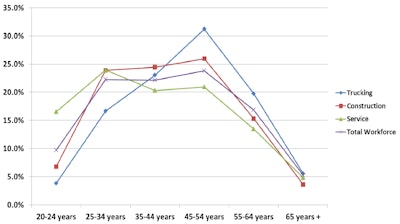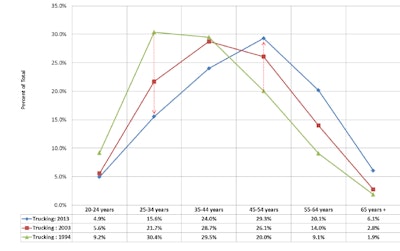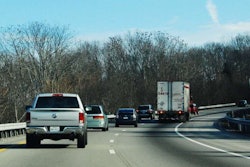In a conference call hosted by Stifel Capital Markets with reporters and others Friday, Feb. 13, American Transportation Research Institute President Rebecca Brewster outlined the shifting age demographics among drivers industrywide. The trucking industry, as illustrated by the following chart, when compared with other prominent industries contains a disproportionately older workforce, with well more than half of drivers above the age of 45.

ATRI’s recent demographics report, available here, was aimed in part at documenting to what extent, if any, this may have been “how we’ve always been operating,” Brewster said. Is trucking truly witnessing a “demographic shift” long-term, in which “our percentage of employees in the 25-34 group have decreased significantly over time”?
Turns out, as has been confirmed by many an anecdote from recent history, the shift is real. The chart below compares driver age demographics utilizing census data at 10- and 20-year lookbacks.

Brewster described a sort of “greatest generation” among drivers operating today, those who started their careers “more than 20 years ago and have stuck with it.” Those drivers, she adds, will retire within the next 10 or slightly more years, and unless more is done to attract those of the younger generations, the current systemic issues many carriers are having with recruiting will not abate.
“We conclude that the shift to older employees is a more recent trend” than previously thought, she said — “post-2003, and it might be related to the Great Recession, when a lot of people left and simply didn’t return,” seeking out careers in other industries.
Brewster reinforced ideas that have been discussed among carrier advocacy groups to tackle the issues, such as the “graduated CDL” idea to bridge the eligibility gap between high-school graduation and age 21, likewise a push for more vocational education in high school about careers in transportation, including truck operation.
But she also noted data sources that could help carrier operations teams better plan routes to help improve the driver’s experience on the road, avoiding the pitfalls on long-distance hauling. One such tool is ATRI’s report on the top freight bottlenecks in the nation. Dive into that study and you’ll find ideal times for traversing those bottlenecks, when the average speed has historically been highest.
Often, however, that’s the midnight-5 a.m. period, which happens also to be the one off-limits to any driver taking a restart prior to the Congressionally-forced change to the Federal Motor Carrier Safety Administration’s 2013-implemented restart restrictions, widely considered to have compounded daytime congestion — and nighttime and other parking — issues.
 Brewster referenced this comparison table, showing drivers’ and carrier reps’ top issues, named in the fall of 2014 in ATRI’s top trucking issues survey, to illustrate some of the similarities between the concerns of the two populations. “What can we,” she asked, “as an industry do to turn this large ship in a different direction?”
Brewster referenced this comparison table, showing drivers’ and carrier reps’ top issues, named in the fall of 2014 in ATRI’s top trucking issues survey, to illustrate some of the similarities between the concerns of the two populations. “What can we,” she asked, “as an industry do to turn this large ship in a different direction?”The battle with the Federal Motor Carrier Safety Administration over the hours of service’s restart restrictions saw a certain amount of concurrence between drivers’ and carriers’ concerns, and illustrated how important hours flexibility had become for drivers navigating an increasingly congested, and dangeous, highway system. It will be difficult, she said, to keep drivers in trucking if “the drivers are forced … to drive during periods of increased risk” due to the nature of the hours of service regulations.










